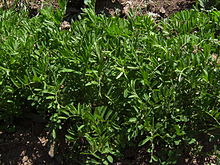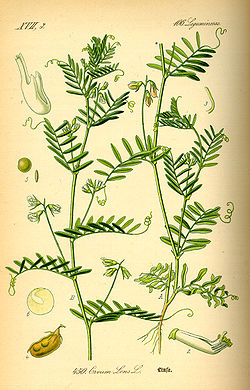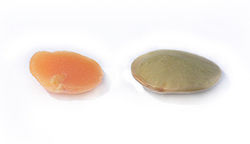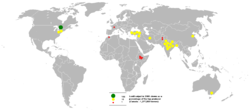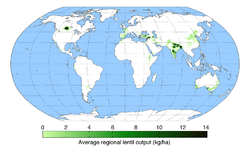- Lentil
-
This article is about the species Lens culinaris. For the meaning of "lentil" in Indian English, see pulse (legume). For the toor (sometimes called "lentil" in Indian English), see pigeon pea.
Lentil 
Lentils Scientific classification Kingdom: Plantae (unranked): Angiosperms (unranked): Eudicots (unranked): Rosids Order: Fabales Family: Fabaceae Subfamily: Faboideae Tribe: Vicieae Genus: Lens Species: L. culinaris Binomial name Lens culinaris
MedikusThe lentil (Lens culinaris) (International Feed Number, 5-02-506) is an edible pulse. It is a bushy annual plant of the legume family, grown for its lens-shaped seeds. It is about 40 centimetres (16 in) tall and the seeds grow in pods, usually with two seeds in each.
Contents
Background
The plant likely originated in India and Pakistan,[1] and lentils have been part of the human diet since the aceramic (pottery nonproducing) Neolithic times, being one of the first crops domesticated in the Near East. Archeological evidence shows they were eaten 13,000 to 9,500 years ago.[2]
Lentil colors range from yellow to red-orange to green, brown and black.[2] Lentils also vary in size (e.g., Masoor lentils, shown in photos here), and are sold in many forms, with or without the skins, whole or split.
Other pulses are sometimes called lentils, but are actually beans or peas, e.g., "black lentils" (urad beans).
Types
- Brown/Spanish pardina
- French green/puy lentils (dark speckled blue-green)
- Green
- Black/beluga (not actually true lentils; see urad bean)
- Yellow/tan lentils (red inside)
- Red Chief (decorticated yellow lentils)
- Eston Green (Small green)
- Richlea (medium green)
- Laird (large green)
- Petite Golden (decorticated lentils)
- Masoor (brown-skinned lentils which are orange inside)
- Petite crimson/red (decorticated masoor lentils)
- Macachiados (big Mexican yellow lentils)
The seeds require a cooking time of 10 to 30 minutes, depending on the variety–shorter for small varieties with the husk removed, such as the common red lentil–and have a distinctive, earthy flavor. Lentils are used throughout South Asia, the Mediterranean regions and West Asia. They are frequently combined with rice, which has a similar cooking time. A lentil and rice dish is referred to in western Asia as mujaddara or mejadra. Rice and lentils are also cooked together in khichdi, a popular dish in the Indian and pakistan subcontinent; a similar dish, kushari, made in Egypt, is considered one of two national dishes. Lentils are used to prepare an inexpensive and nutritious soup all over Europe and North and South America, sometimes combined with some form of chicken or pork.
Dried lentils can also be sprouted by leaving in water for several days, which changes their nutrition profile.
Lentils with husk remain whole with moderate cooking; lentils without husk tend to disintegrate into a thick purée, which leads to quite different dishes.[3]
Nutritional value and health benefits
Lentils, raw (dry weight) Nutritional value per 100 g (3.5 oz) Energy 1,477 kJ (353 kcal) Carbohydrates 60 g - Sugars 2 g - Dietary fiber 31 g Fat 1 g Protein 26 g Water 10.4 g Thiamine (vit. B1) 0.87 mg (76%) Folate (vit. B9) 479 μg (120%) Calcium 56 mg (6%) Iron 7.54 mg (58%) Magnesium 122 mg (34%) Phosphorus 451 mg (64%) Potassium 955 mg (20%) Sodium 6 mg (0%) Zinc 4.78 mg (50%) Percentages are relative to US recommendations for adults.
Source: USDA Nutrient DatabaseWith about 30% of their calories from protein, lentils, like other legumes, have the third-highest level of protein, by weight, of any plant-based food, after soybeans and hemp.[4] Proteins include the essential amino acids isoleucine and lysine, and lentils are an essential source of inexpensive protein in many parts of the world, especially in the West Asia and the Indian subcontinent, which have large vegetarian populations.[5] Lentils are deficient in two essential amino acids, methionine and cysteine.[6] However, sprouted lentils contain sufficient levels of all essential amino acids, including methionine and cysteine.[7]
Lentils also contain dietary fiber, folate, vitamin B1, and minerals. Red (or pink) lentils contain a lower concentration of fiber than green lentils (11% rather than 31%).[8] Health magazine has selected lentils as one of the five healthiest foods.[9] Lentils are often mixed with grains, such as rice, which results in a complete protein dish.
Lentils also have antinutritional factors, such as trypsin inhibitors and relatively high phytate content. Trypsin is an enzyme involved in digestion, and phytates reduce the bioavailability of dietary minerals.[10] The phytates can be reduced by soaking the lentils in warm water overnight.
Lentils are a good source of iron.[11]
Production
Lentils are relatively tolerant to drought, and are grown throughout the world. FAO reported the world production of lentils for calendar year 2009 was 3.917 million metric tonnes, primarily coming from Canada, India, Turkey and United States.
About a quarter of the worldwide production of lentils is from India, most of which is consumed in the domestic market. Canada is the largest export producer of lentils in the world, and Saskatchewan is the most important producing region in Canada. Statistics Canada estimates that Canadian lentil production for the 2009/10 year is a record 1.5 million metric tonnes.[12]
The Palouse region of eastern Washington and the Idaho Panhandle, with its commercial center at Pullman, Washington, constitute the most important lentil-producing region in the United States.[13] Montana and North Dakota are also significant lentil growers.[2] National Agricultural Statistics Service reports United States 2007 production at 154.5 thousand metric tonnes.
Top ten lentil producers – 2009 Country Production (tonnes) Footnote  Canada
Canada1,510,200  India
India950,000  Turkey
Turkey302,181  United States
United States265,760  Australia
Australia143,000  Ethiopia
Ethiopia123,777  China
China120,000  Syria
Syria102,461  Iran
Iran83,985  Bangladesh
Bangladesh60,537 World 3,917,923 A No symbol = official figure, P = official figure, F = FAO estimate, * = Unofficial/semiofficial/mirror data, C = Calculated figure A = Aggregate (may include official, semiofficial or estimates);
Current United States production numbers can be found at the NASS database here by selecting the desired items.
Diseases
Main article: List of lentil diseasesIn culture
Lentils are mentioned many times in the Old Testament, the first time recounting the incident in which Jacob purchases the birthright from Esau with stewed lentils (a "mess of pottage").[14] In Jewish mourning tradition, they are considered as food for mourners, together with boiled eggs, because their round shape symbolizes the life cycle from birth to death.
Lentils were the main ingredient in the diet of ancient Iranians, who consumed lentils daily in the form of a stew poured over rice.
Lentils are also commonly used in Ethiopia in a stew-like dish called kik, or kik wot, one of the dishes people eat with Ethiopia's national food, injera flat bread. Yellow lentils are used to make a nonspicy stew, which is one of the first solid foods Ethiopian women feed their babies.
In Shia narrations, lentils are said to be blessed by seventy Prophets including Jesus and Mohammed.[15]
In Italy, eating lentils on New Year's Eve traditionally symbolizes the wish to earn more money next year, most likely because of their round coin-like shape.
In "Cinderella", one of Grimm's Fairy Tales, a task her stepmother assigns Cinderella is fishing lentils out of ash. If she succeeds, she may go to the ball.
See also
- Revalenta arabica, a 19th century patent medicine made of lentils
- Lentil soup
- National Lentil Festival
- Dal
- Moujadara
References
- ^ Bejiga, G. (2006). Brink, M.; Belay, G.. eds. Cereals and Pulses. Plant Resources of Tropical Africa. Wageningen, Netherlands: PROTA Foundation/Backhuys Publishers/CTA. p. 91. ISBN 90-5782-170-2.
- ^ a b c Leah A. Zeldes (16 February 2011). "Eat this! Lentils, a prehistoric foodstuff". Dining Chicago. Chicago's Restaurant & Entertainment Guide. http://www.diningchicago.com/blog/2011/02/16/eat-this-lentils-a-prehistoric-foodstuff/. Retrieved 4 August 2011.
- ^ "Red lentil recipes". BBC. 2011. http://www.bbc.co.uk/food/red_lentil. Retrieved 4 August 2011.[]
- ^ Callaway JC (2004). Hempseed as a nutritional resource: an overview. Euphytica 140:65-72.
- ^ http://www.glisonline.com/aminoacids.php
- ^ http://www.ag.ndsu.edu/pubs/alt-ag/lentil.htm
- ^ http://www.bitterpoison.com/protein/11248
- ^ USDA nutrient database
- ^ Raymond, Joan (March 2006). "World's Healthiest Foods: Lentils (India)". Health Magazine. http://www.health.com/health/article/0,23414,1149140,00.html.
- ^ Effect of processing on some antinutritional factors of lentils. J. Agric. Food Chem.
- ^ http://www.vrg.org/nutrition/iron.htm
- ^ http://www.agr.gc.ca/pol/mad-dam/index_e.php?s1=pubs&s2=spec&PHPSESSID=1d7c05ebd65aa90dd7ff96aba3cc7f64
- ^ Crop Profile for Lentils in Idaho. Department of Plant, Soil and Entomological Science, University of Idaho (web site). 2000
- ^ Genesis 25:34, http://www.mechon-mamre.org/p/pt/pt0125.htm
- ^ Jesus through Shiite Narrations, Chapter: Preaching of Jesus. No. 63 http://www.al-islam.org/jesus_shiite_narrations/21.htm
Further reading
- Alan Davidson, The Oxford Companion to Food. ISBN 0-19-211579-0
- S S Yadav et al. Lentil: An Ancient Crop for Modern Times. (2007). Springer Verlag. ISBN 9781402063121.
External links
- Crop Wild Relatives Gap Analysis Portal reliable information source on where and what to conserve ex-situ, regarding Lens genepool
- All types of lentils & uses
- Information on Cooking Lentils
- Lentils - Country Production, Consumption, Exports, and Imports Statistics
- Alternative Field Crops Manual: Lentil
Categories:- Faboideae
- Edible legumes
- Vietnamese ingredients
Wikimedia Foundation. 2010.

